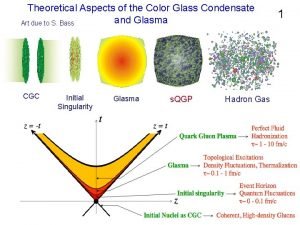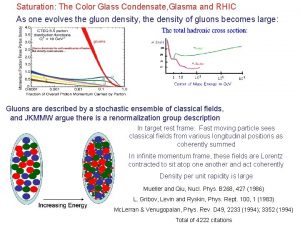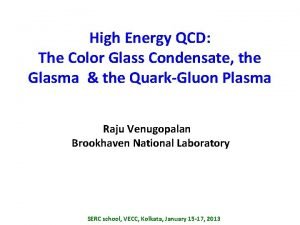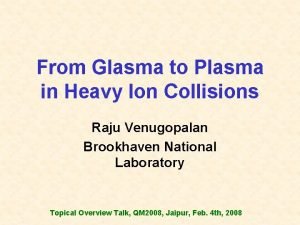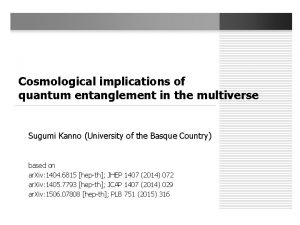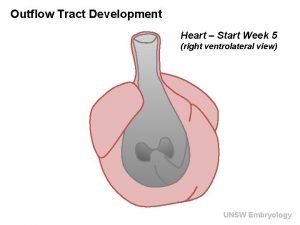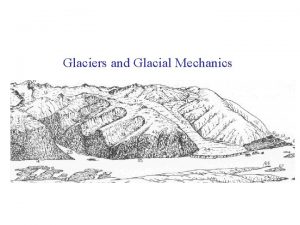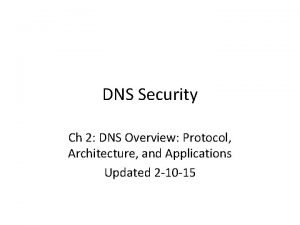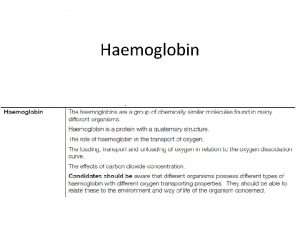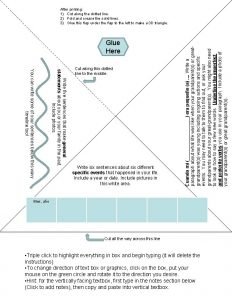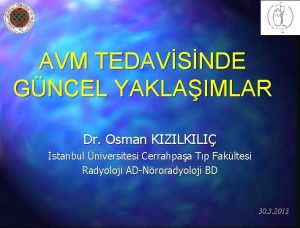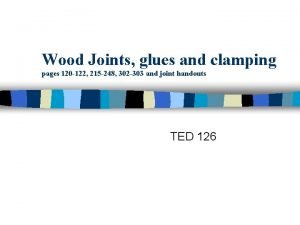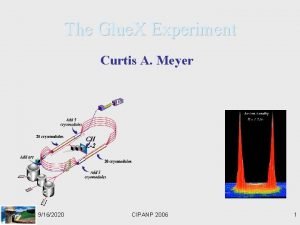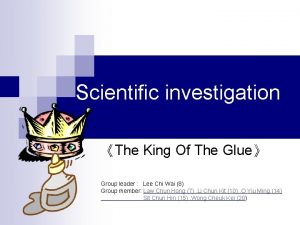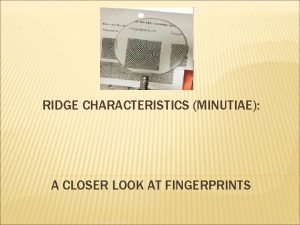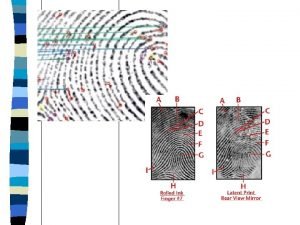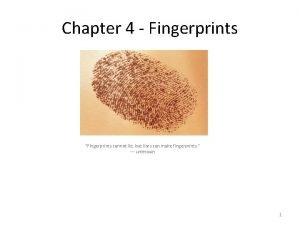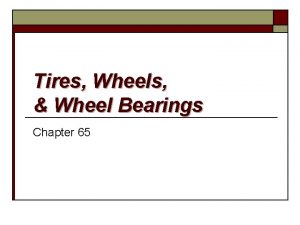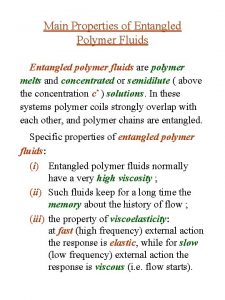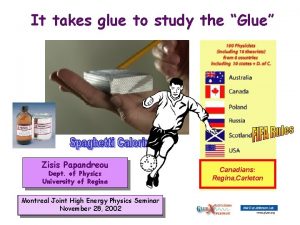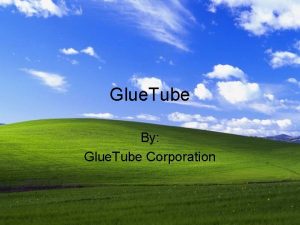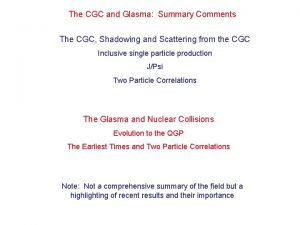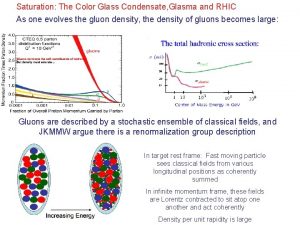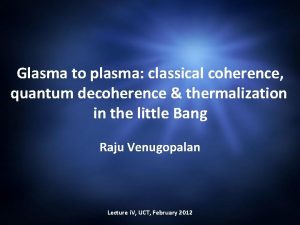Ridges from the Glasma Entangled glue and collective
























































- Slides: 56

Ridges from the Glasma: Entangled glue and collective flow Raju Venugopalan Brookhaven National Laboratory WWND 2014, Galveston, TEXAS

What are we trying to learn? u What is the underlying QCD mechanism of the ridge? u Is there “spooky quantum mechanics” at work a la photon or spin entanglement ? u How far can we extend the collective flow paradigm – and do we see systematic deviations? u Are hadronization patterns universal QCD physics or do they reflect thermal abundances Cool, exciting stuff experiments are beginning to answer

What all ridges share across system size • Systematic dependence on multiplicity of event • Long range near and away side rapidity correlations • Azimuthal anisotropies, decomposed into Fourier harmonics • Similar (? ) hadronization patterns

What ridges do not share across system size A) Mini-jets patterns are very different: i) Completely un-modified in p+p high multiplicity events ii) Strongly modified in A+A iii) Jury out in p+A. Answer depends on p. T window of interest B) Dissimilar (? ) hadronization patterns – p/π and K/π ratios are more alike than not in p+p and p+A -- show significant changes for more central A+A events C) HBT radii: significantly different slopes in p+p and A+A. Just out—p+A slopes are close to p+p (ALICE results: 1404. 1194) Event structure not identical in p+p, p+A, A+A -- gloss over these differences at your peril

Multiparticle production in p+p What does it take to produce ~ 150 hadrons per 5 units of rapidity in a single p+p event ? What’s the guidance from HERA?

Multiparticle production What does it take to produce ~ 150 hadrons per 5 units of rapidity in a single p+p event ? For λ=0. 14, get about 13 gluons produced in 5 units ~ min. bias hadron multiplicity λ=0. 3: ~45 gluons in 5 units, λ=0. 4: ~90 gluons in 5 units, in ball park… Very rapid growth of gluon dist. in such events…

The proton in a high multiplicity event Y=ybeam π π π Y=0 π π π For Q 2= 2 Ge. V 2, , what’s the proton’s gluon radius?

The proton in a high multiplicity event Y=ybeam π π π Y=0 π π π For Q 2= 2 Ge. V 2, , what’s the proton’s gluon radius? Gribov diffusion => R 2 ~ ln(s) Rg grows much faster depending on Ng rate --will violate unitarity Saturation regulates this by adding increasingly “smaller” gluons of size 1/Qs(x) with decreasing x

Lasing gluons: Stimulated emission from Glasma flux tubes Dumitru, Gelis, Mc. Lerran, RV (2008) Dusling, Fernandez-Fraile, RV (2009) Gelis, Lappi, Mc. Lerran (2009) Color combinatorics of cut graphs: a negative binomial distribution

Lasing gluons: Stimulated emission from Glasma flux tubes Dumitru, Gelis, Mc. Lerran, RV (2008) Dusling, Fernandez-Fraile, RV (2009) Gelis, Lappi, Mc. Lerran (2009) Color combinatorics of cut graphs: a negative binomial distribution k=1: Bose-Einstein dist. k=∞: Poisson distribution For QS 2 ≈ 1/ST close to a Bose-dist!

There are ~ πR 2 QS 2 flux tubes a: shattering CGCs Lappi 0711. 3039 Ng ~ 100 in 5 units for QS 2 ~ 2 Ge. V 2 To produce large # of particles, to satisfy constraints from Unitarity, Causality and Confinement requires a semi-hard scale. 1206. 6805 1311. 3636 Schenke, Tribedy, Venugopalan

2 particle correlations in p. QCD: counting powers

2 particle correlations in p. QCD: counting powers Gluons with k. T ~ QS resolve n ~ 1/g 2 color sources Effective coupling: g*n ~ 1/g Glasma graphs enhanced in high mult. events by αS-8

The saturated hadron: Glasma graphs Dumitru, Gelis, Mc. Lerran, RV: 0804. 3858 Gelis, Lappi, RV, ar. Xiv: 0807. 1306 Weights give energy dependence of large x sources From solns. of Yang-Mills eqns. with two light cone sources Includes all mult. scat. contributions (gρ1)n and (gρ2)n Caveat: valid for Δypq < 1/αS

Glasma graphs-key features Glasma graphs generate long range rapidity correlations Suppressed for QS << p. T by powers of αS AND NC (At high p. T, large x or large impact parameters) Glasma graphs enhanced by 1/αS 8 for high occupancy fields -- factor of 105 for typical αS ! (central impact parameters, small x, low p. T, large nuclei)

Angular structure from (mini-) Jet radiation p GBFKL q NLO in the dense-dense framework but… unsuppressed in NC Caveat: does not include multiple scattering contributions which may be significant for k. T < QS

Anatomy of long range collimation

Quantitative description of pp ridge Dusling, RV: PRL 108 (2012)262001 Dependence on transverse area cancels in ratio… Caveat: k. T factorized approximation used for quantitative comparisons – mult. scatt. contributions, of same order, important for k. T < QS

Quantitative description of pp ridge Dusling, RV: PRL 108 (2012)262001 Dependence on transverse area cancels in ratio… Rarer and rarer gluon configurations probed in the proton

Systematics of p+p correlated yield Data from CMS collaboration Fits: Dusling, RV, ar. Xiv: 1302. 7018

Dusling, RV, PRD 87, 051502 (R) (2013); ar. Xiv: 1302. 7018

What about p+A ? Ridge much bigger than p+p for the same multiplicity p+A ridge nearly as large as peripheral Pb+Pb

Systematics of associated yield in p+Pb Q 0 2(lead)=N Part Pb * Q 0 2(proton) Dusling, RV: 1302. 7018 # of “wounded” nucleons in lead nucleus Very large Ntrk in p+Pb is probing very rare configurations inside proton

LHC p+A vs A+A collisions Peripheral A+A Central p+A

Further systematics of p+Pb associated yield Dusling, RV: 1211. 3701 1302. 7018

Anatomy of long range di-hadron collimation BFKL Mini-jet Glasma graphs Associated Di-hadron Yield

“Jet subtracted” p+Pb ridge Similar subtraction in RHIC d+Au to extract ridge

v 3 in LHC p. A collisions CMS 1305. 0609 v 3 > 0 not obviously obtained from Glasma graphs in k. T factorization approximation Only even moments obtained…

Are there sources of v 3 in the Glasma? CGC/Glasma yield Jet/Glasma Interference Jalilian-Marian, Kovchegov Baier, Kovner, Nardi, Wiedemann Fukushima, Hidaka Iancu, Laidet “p. QCD” jet Jet/Glasma interference term –assumed small previously

Are there sources of v 3 in the Glasma? Dusling+RV, in preparation Glasma graphs Jet graph We recently finished a computation of this long range quantum interference contribution Jet-Glasma quantum interference

Triangular azimuthal anisotropy in p+A collisions Does this generate positive a 3 ?

Triangular azimuthal anisotropy in p+A collisions

Triangular azimuthal anisotropy in p+A collisions

Triangular azimuthal anisotropy in p+A collisions Sym: same QS 0, as in A+A peripheral collisions Asym: unequal QS 0 in projectile and target as in p+A

Conclusions u The Glasma framework allows for systematic study of multi-particle production in p+p, p+A and A+A collisions u The p+p ridge can be quantitatively understood from gluon saturation enhanced quantum interference Glasma graphs + BFKL graphs u The A+A ridge and vn moments are quantitatively described in the same framework by IP-Glasma initial conditions + flow (See Bjoern Schenke’s talk tomorrow for the latest)

Conclusions u The p/d+A ridge situation is not fully clear u 2 -part corr. data are described by Glasma+BFKL dynamics within systematic uncertainties. u We showed here that a triangular azimuthal anisotropy is generated by quantum interference effects. 4 and higher point anisotropies can also be computed, though the computation is challenging.

The Glasma: shattering CGCs Ø Extreme multi-particle production requires a universal semi-hard scale in the proton of order few Ge. V Ø High occupancy=> particle production described by classical fields Ø Approximately boost invariant

Color correlations: Glasma graphs Leading correlated graph ~ 1 / αS 2 NC 2 Distributions fall as ~ QS 4/p. T 4 * QS 4/q. T 4


Systematics of p+p correlated yield Data from CMS collaboration Fits: Dusling, RV, ar. Xiv: 1302. 7018

d+Au ridge at RHIC

d+Au ridge at RHIC

d+Au ridge at RHIC

d+Au ridge at RHIC

d+Au ridge at RHIC PHENIX, 1303. 1794

d+Au ridge at RHIC But: does a d+Au ridge exist at RHIC ? Talk by Fuqiang Wang, RBRC workshop, April 15, 2013 STAR argues nearside ridge goes away with increasing Δη … Where does this leave the hydro explanation ? Centrality dependence will be important…

Physics underlying the ridge Look at ratio of yield at Δφpq = 0 to Δφpq=π for |p. T|=|q. T| As seen in the LHC p+Pb data…

Long range di-hadron correlations Gelis, Lappi, RV (2009) Simplify using “Gaussian truncation” approximation to JIMWLK Dusling, Gelis, Lappi, RV: 0911. 2720

The saturated hadron: Glasma graphs-I RG evolution: + Dumitru, Gelis, Mc. Lerran, RV: 0804. 3858 Gelis, Lappi, RV, ar. Xiv: 0807. 1306 + … Keeping leading logs to all orders (NLO+NNLO+…) = LO graph with energy dependence of each evolved source described by weight functional W[ρ] Avg. over sources in each event and over all events gives correlation

Nearside collimation: quantum interference of glue Dumitru, Dusling, Gelis, Jalilian-Marian, Lappi, RV, ar. Xiv: 1009. 5295 RG evolved leading Glasma contribution expressed in terms of “unintegrated gluon distributions” in the proton Proton 1 Proton 2

Nearside collimation: quantum interference of glue Dumitru, Dusling, Gelis, Jalilian-Marian, Lappi, RV, ar. Xiv: 1009. 5295 RG evolved leading Glasma contribution expressed in terms of “unintegrated gluon distributions” in the proton Proton 1 Proton 2 Caveat: k. T factorized approximation to full RG simulation -- coherent multiple scattering effects – possibly large for k. T < QS -- not included

Nearside collimation: quantum interference of glue From RG evolution of BK equation Q 0

Collimated yield ? From RG evolution of BK equation Q 0 Dominant contribution from | p. T-k. T| ~ |q. T-k. T| ~ |k. T| ~ QS This gives a collimation for ΔΦ ≈ 0 and π

Are there sources of v 3 in the Glasma? For k. T ≤ QS: coherent multiple scattering contributions are important – all of same order in QCD coupling × × Not included in k. T factorization framework Can be computed by solving Yang-Mills equations for the Glasma Lappi, Srednyak, RV: 0911. 2068 In dilute-dense context, see Kovchegov, Wertepny, 1212. 1195

Can v 3 be obtained in the Glasma? Lappi, Srednyak, RV: 0911. 2068 Schenke, RV: in preparation IP-Glasma results are preliminary-no centrality selection, etc. In principle extract v 2{4} too— Systematic study for peripheral A+A feasible…

Long range di-hadron correlations Gelis, Lappi, RV (2009) Simplify using “Gaussian truncation” approximation to JIMWLK Dusling, Gelis, Lappi, RV: 0911. 2720
 Color glass condensate
Color glass condensate Glasma fashion
Glasma fashion Glasma fashion
Glasma fashion Shoshiwong
Shoshiwong Do not be entangled with the affairs of this world
Do not be entangled with the affairs of this world Multiverse (entangled)
Multiverse (entangled) The potion contained fruit biscuits and glue
The potion contained fruit biscuits and glue Scissors and glue stick
Scissors and glue stick Bulbar ridges
Bulbar ridges Zone of accumulation glacier
Zone of accumulation glacier Check glue records
Check glue records What are glue words
What are glue words Glue record dns
Glue record dns Erd vs erm
Erd vs erm Aws sts icon
Aws sts icon Second degree burn from hot glue gun
Second degree burn from hot glue gun Structure of haemoglobin
Structure of haemoglobin Glue sentence for class 1
Glue sentence for class 1 Nbca glue
Nbca glue Anchor pins floral design
Anchor pins floral design Phobia of glue
Phobia of glue Lignosulfonate glue price
Lignosulfonate glue price Crazy glue
Crazy glue Pva glue wiki
Pva glue wiki Glue
Glue Pwa glue
Pwa glue The glue group
The glue group Permanent and temporary joints
Permanent and temporary joints Cyanoacrylate fuming definition
Cyanoacrylate fuming definition Aws glue gui
Aws glue gui Asymptote examples
Asymptote examples Examples of ridge characteristics
Examples of ridge characteristics Ruffles own your ridges
Ruffles own your ridges Inner terminus
Inner terminus Epoophoron
Epoophoron Chapter 7 aquatic ecosystems
Chapter 7 aquatic ecosystems Occipital lobe main function
Occipital lobe main function Fissures and gyri
Fissures and gyri Retromylohyoid area
Retromylohyoid area Chapter 9 environmental science
Chapter 9 environmental science Short ridge fingerprint
Short ridge fingerprint Atwood's classification of residual ridges
Atwood's classification of residual ridges Open center curls
Open center curls Vermillion border
Vermillion border Chop theory salon
Chop theory salon Conotruncal region
Conotruncal region Minutiae
Minutiae Stiff sidewall tires
Stiff sidewall tires 12 ridge characteristics of fingerprints
12 ridge characteristics of fingerprints Hát kết hợp bộ gõ cơ thể
Hát kết hợp bộ gõ cơ thể Ng-html
Ng-html Bổ thể
Bổ thể Tỉ lệ cơ thể trẻ em
Tỉ lệ cơ thể trẻ em Gấu đi như thế nào
Gấu đi như thế nào Thang điểm glasgow
Thang điểm glasgow Hát lên người ơi alleluia
Hát lên người ơi alleluia Môn thể thao bắt đầu bằng từ đua
Môn thể thao bắt đầu bằng từ đua
